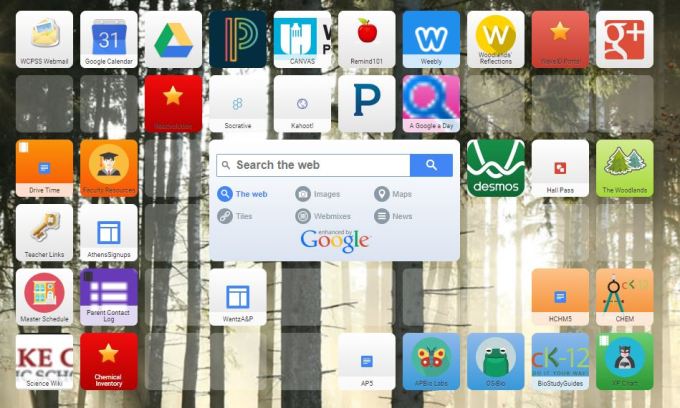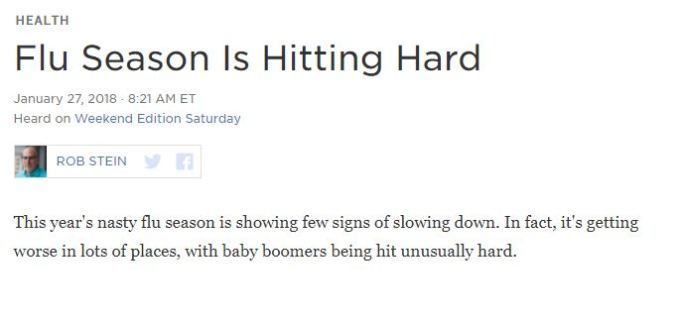In this issue of Inspiration for Innovation: the current flu season, resource compilations for projects to get away from direct instruction, creating a culture of inquiry, and using a classroom climate survey to gauge social-emotional learning in any classroom.
Current Event (Magnet Tie-in)
Click the image below to take you to the NPR article. Side note: NPR has both the audio files and written transcripts for most of their stories. This is actually an interview, so it may be better in the audio version.
Potential lesson/talking points:
- What are some reasons that the flu vaccine is not always as effective as other vaccines?
- How do vaccinations work?
- How is the flu vaccine produced?
- What are some other devastating flu epidemics in history?
- What kind of data is available from the CDC and how does it let us study the current flu epidemic?
- What are the symptoms of the flu and when should you go to the doctor?
- What would be the best way to tell someone that they are very ill?
- How could you persuade people to get vaccinated?
Tech Tools
Resource compilations for projects.
Something I’ve heard around the proverbial water cooler a lot lately is, “I want to incorporate more projects, but I have to get some background knowledge to the students first, so I still have to use a lot of direct instruction.” Well, I’m all for using direct instruction to go over information that is especially difficult or involves teaching a new skill to students. There is not “one lesson plan to rule them all” by any means. Part of the art of teaching involves discerning the most effective strategies to employ for different applications of content. However, I am a naysayer when it comes to direct instruction for basic background information.
I know more people are incorporating flipped classes or flipped lessons (I do too, from time to time), but another strategy that I absolutely love is giving students a pile of handpicked resources that can provide them with the same information. After all, a flipped lesson is still direct instruction, you’re just asking them to do it at home instead of face-to-face.
Here are my favorite platforms (with examples that I use in my classes) for providing students a pile of resources that are more aesthetically pleasing than a list of links in a GoogleDoc (I use those too):
- PadletHeredity Exploration (AP Bio review of honors biology concepts)
- Tes (Blendspace)Pre-Chemistry lesson
-
- Incidentally, it has been viewed over 2000 times, so I think other people are using it or copying it for their own class, which you can do with public ones.
- Symbaloo, okay, okay, I don’t have one for a lesson yet, but as you can see below, you can create a page with a pile of tiles that link to other content. I use this to get through my day without having 100 tabs open in my web browser.

Another important factor is to give students specific tasks to accomplish as they interact with the content you’ve given them. As an example, here’s the previously rebuffed Google Doc Nitrogen Station Investigation (and the student stations sheet) I use in chemistry, but it’s a good example of investigation tasks. It’s actually one station out of four, but you get the idea.

Please feel free to contact me if you want some help building a resource compilation for a lesson. All you need to prepare ahead of time is the actual list of resources you want students to use.
Teaching Strategy
Fostering a culture of inquiry, by Suzie Boss.
Suzie Boss is one of the major proponents of project-based learning. She has a small book, Real World Projects, that walks educators through the actual process of project design. It doesn’t pontificate on all the reasons to incorporate PBL, but rather provides an actual, practical step-by-step guide on how to do it.
Side note: You can get one for free plus an amazing professional opportunity through Wake Education Partnership’s program, SummerSTEM (only for Wake County Teachers). Applications are accepted in the spring for the following summer.
In the article, the director of the Calgary Science Schools says, “We focus on more than just science education. Rather, we’re trying to embed the disposition of a scientist into everything we do — we want everyone in our community doing research, critically thinking, and collaboratively building knowledge.”
This article brings about the major change that needs to happen in a dynamic, student centered learning environment: a culture that encourages students to ask questions and find their own answers with the teacher facilitating the learning process and ensuring that it connects to their curriculum.
One of the greatest compliments I’ve received from a student was how much he appreciated that I encouraged students to ask questions. This statement rather surprised me because I wondered how he was made to feel that his level of questioning was discouraged in other teachers’ classes. Granted, this was a rather brilliant student and his questions would often go far beyond our curriculum, despite their relevancy. I will be the first to tell you that I am not afraid to say, “I don’t know,” and I think we should all embrace that, since we are also promoting having a growth mindset. However, I don’t just say, “I don’t know,” but rather, “I’m not sure right now, but here are a few sources that might have a good explanation. Let’s look at them together and see what we can find out.”
Often, I believe our AIG classified students don’t get challenged enough because we are so busy trying to make sure our at-promise students make it through our course. Allowing these students to ask their sometimes seemingly outlandish questions can lead to a fantastic sidebar discussion, encourage them to stay curious, and empower them to help find the answers.
Positivity
Classroom Climate Survey.
My second PDP goal for the year is to build better relationships with my students. I am fairly proud of my ability to do this, but I often get told by my AP students who previously had me for chemistry that I am “intimidating” and sometimes even “scary.” I’m 5’2″ so I find this hard to believe, but I’m trying to listen. I wanted to work on being my AP Biology-teacher-self with my chemistry students, with whom I spend less time (a whole year versus one semester, respectively).
In our resources, I found that we could use a classroom climate survey to gather data for this particular goal. Being a former scientist and general nerd, I like data! I also like research. So I did a bit and found a paper… and of course I can’t find it now. I guess you’ll have to take my word for it. It was a scientific paper that included the actual survey questions used in the methods section. I changed it so that all of the statements are positive, and on a scale of 1-5. This will give you an actual score (out of 100, so a grade, I guess) to know about the culture that you have created. Here’s the form I made. Feel free to copy it and use it in your own class or tweak it to your heart’s desire.
Speaking of research papers… APA format is the way to go if you want to incorporate scientific writing and the GoogleDocs Explore tool and APAstyle.org are wonderful things.


